Travels with a TeleVue 85 Apochromatic Refractor
By Antony McEwan
There are many TeleVue 85 refractors out there, and consequently there are many reviews of the TeleVue 85 out there too. They all praise the superb optics, outstanding workmanship and the versatility of the little APO. So what else is there left to say? Well, I thought in this ‘review’ I’d focus on the telescope’s ability to perform as a Travel-Scope; on its portability and ease of use in a holiday situation, when space and weight count and versatility is all-important.
The Telescope
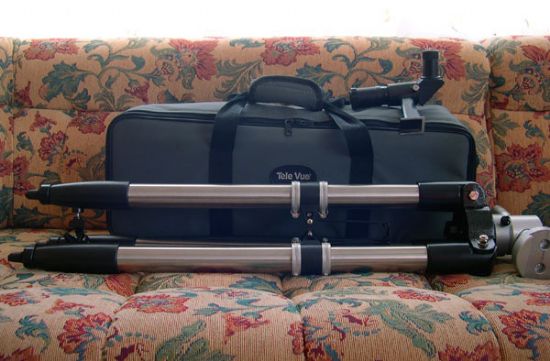 The TeleVue 85 is an apochromatic doublet refractor of 85mm aperture and 600mm focal length. It has a super-smooth 2” rack and pinion focuser, weighs 8lb unloaded, and measures 21.5” in length. With a good 2” diagonal and a small finder added the weight increases to between 9lb and 10lb. The 2” focuser allows the use of a 2” diagonal, which means 2” barrel diameter eyepieces can be used. These provide wider fields of view than most 1.25” diameter eyepieces, so stunning wide field views can easily be obtained with the TeleVue 85. Mid-power views are also beautiful through this ‘scope, and by using short focal length eyepieces, or by adding a barlow lens to medium focal length ones, high power views can also be achieved which maintain the high levels of contrast and sharpness inherent to the TeleVue’s design. Being apochromatic, false colour around bright objects is not an issue. I have had this telescope for just over two years, since buying it second-hand, which in itself is quite a rarity as people tend to hang onto them! In fact, when I begin to wind down my visual observing in 60 or 70 years time, I’ll have to start thinking about who to pass this ‘scope on to…
The TeleVue 85 is an apochromatic doublet refractor of 85mm aperture and 600mm focal length. It has a super-smooth 2” rack and pinion focuser, weighs 8lb unloaded, and measures 21.5” in length. With a good 2” diagonal and a small finder added the weight increases to between 9lb and 10lb. The 2” focuser allows the use of a 2” diagonal, which means 2” barrel diameter eyepieces can be used. These provide wider fields of view than most 1.25” diameter eyepieces, so stunning wide field views can easily be obtained with the TeleVue 85. Mid-power views are also beautiful through this ‘scope, and by using short focal length eyepieces, or by adding a barlow lens to medium focal length ones, high power views can also be achieved which maintain the high levels of contrast and sharpness inherent to the TeleVue’s design. Being apochromatic, false colour around bright objects is not an issue. I have had this telescope for just over two years, since buying it second-hand, which in itself is quite a rarity as people tend to hang onto them! In fact, when I begin to wind down my visual observing in 60 or 70 years time, I’ll have to start thinking about who to pass this ‘scope on to…
The Trip
These events took place in September 2005, when I was on a 10-day holiday to the village of Frodsham in Cheshire, northwest England. I was staying on a holiday park about a mile and a half outside the village, in a static caravan. I have stayed, and observed from, there before and found the skies to be quite good, though there is some noticeable light pollution from the nearby villages and the city of Liverpool is not too far away.
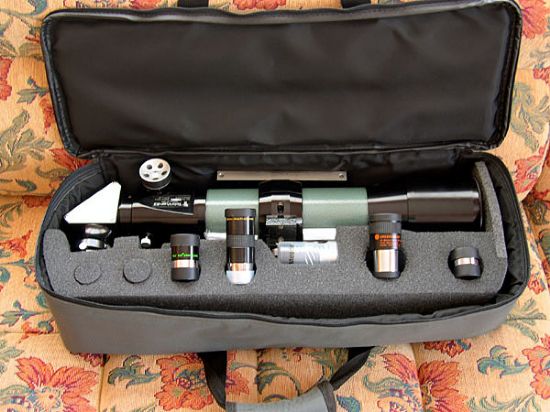
Now I knew that there would not be much space to carry a load of astronomical gear in the back of a Ford Fiesta, so I had to travel light. An equatorial mount would be out of the question, so I decided to take my Tele-Optic Giro Mini alt-azimuth mount, and attach it to a borrowed tripod from a Synta EQ5 mount. The Giro Mini on EQ5 tripod is a lightweight set-up that moves very smoothly and carries the TeleVue 85 sufficiently well to allow moderately high magnifications to be used. I knew that I would be frustrated if I did not take a finder-scope with me, so I took the smallest and lightest that I own: an Orion 6x30 right-angled one that gives a correctly oriented view, much like in binoculars. This would attach to the clamshell ring that holds the ‘scope to the mount. As this is always at the balance point of the tube, the addition of a finder-scope would not affect the balance of the ‘scope, which is important when using an alt-azimuth mount.
For eyepieces I had to sit down and work out what magnifications I would be using, and which eyepieces to take that would be similar in weight and would take up as little space as possible. Having 25+ eyepieces didn’t make this easy, but I managed! I settled on the following selection:
Eyepiece...............................Magnification... Plus 2x Barlow
Meade 32mm Plossl..........................19x.................38x.........
TeleVue 21mm Plossl........................29x.................58x.........
TeleVue 10.5mm Plossl......................58x...............116x.........
Meade 6.7mm Ultra-wide angle.........90x................180x........
Celestron Ultima 2x Barlow....................................................
Note that magnification values have been rounded up to the nearest whole number for simplicity’s sake. This selection gave me a huge choice of magnifications, ranging from 19x (with a true field of view of 2.5 degrees) for glorious low power views, right up to 180x if needed. For reasons explained below, it was important that the eyepieces were all about the same weight, and I had also limited myself to a selection of eyepieces that would fit in the TeleVue carrying case- no additional cases! In the event, there was even room for my Ultra High Contrast and OIII filters, as you can see in the picture.
Some notes on the mount
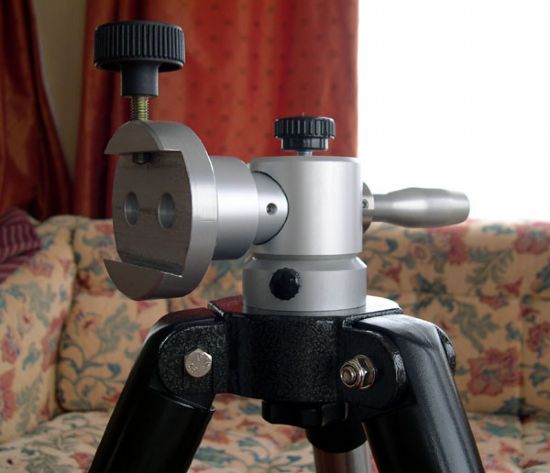 The mount I used for this trip was a Tele-Optic Giro Mini mount. It is a lightweight yet beautifully engineered mount that attaches to any tripod with a 3/8” or M10 fitting. It simply screws on top of the tripod. On one side is a steering arm, on the other a Baader grab-arm with a locking knob. The TeleVue 85 has a clamshell ring that can be, and was, attached to a dovetail plate. The dovetail plate slots into the Baader grab-arm, and the locking knob is tightened. This holds everything in place.
The mount I used for this trip was a Tele-Optic Giro Mini mount. It is a lightweight yet beautifully engineered mount that attaches to any tripod with a 3/8” or M10 fitting. It simply screws on top of the tripod. On one side is a steering arm, on the other a Baader grab-arm with a locking knob. The TeleVue 85 has a clamshell ring that can be, and was, attached to a dovetail plate. The dovetail plate slots into the Baader grab-arm, and the locking knob is tightened. This holds everything in place.
The mount has two tension lock screws: one for the altitude axis and one for azimuth (left to right movement). To lock the telescope in place when it is pointing at something, the tension screws are tightened. To allow for panning the ‘scope around, they are loosened. Theoretically you can have them set halfway to allow a varying degree of friction control, but in my experience I have only been able to have them locked tight or completely open. This may be because the TeleVue 85 is at the upper limit of the mount’s capacity.
The picture below shows the various components used in mounting the telescope. The telescope tube is enclosed within the black Clamshell Ring, which screws to the long Dovetail Plate. That is held in the Baader Grab-Arm, and the Grab-arm attaches to the Giro Mini mount itself.
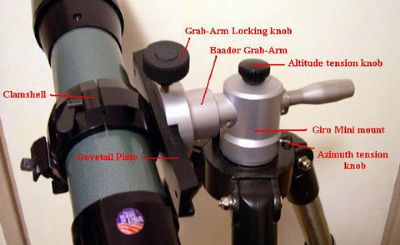
The beauty of an alt-azimuth mount for this type of observing is its simplicity. There is no need to polar-align it or calibrate anything mechanical, or align on multiple stars before being able to observe anything- you just extend the tripod legs, set it level, and attach the telescope. Easy. There are a couple of downsides though. As you will see, viewing near zenith can be tricky as it may require some repositioning of the tripod legs to allow clearance for the ‘scope body. It also reveals about the only shortcoming I can find with the TeleVue 85- the fact that the focuser is machined to be so smooth that there is not quite enough tension to keep the drawtube from slipping when the telescope is pointing at a high angle of elevation. There is a tension knob on the top of the focuser to allow more tension to be applied though, and this solves the problem quite well.
This mounting arrangement is also extremely sensitive to the weight distribution along the length of the telescope tube. If the telescope is too far forward in the grab-arm, it will be nose-heavy and tip downwards when left loose; if too far back, tail-heavy and it will rise. It is important to balance the tube within the grab-arm so that it will stay in any position without slipping in either direction. It only takes a minute to do, and as long as the different eyepieces used in a viewing session are of comparable weight it shouldn’t be a problem.
The final issue is the lack of motor-driven tracking. The only way to track with this set-up is by hand, requiring regular little nudges to the tube to bring the target into the field of view again after it drifts towards (or beyond) the edge. Anyone used to using a Dobsonian won’t have a problem with this, and using wide-angle eyepieces alleviates the situation, although the short focal length of the TeleVue 85 does give quite wide fields even with standard Plossl types so it’s not really a big deal.
My 'Observatory'
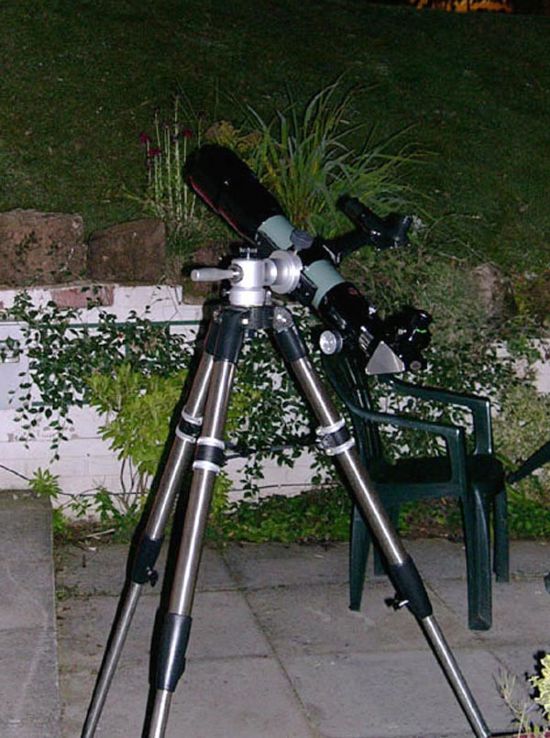 The holiday park where I was staying was set on a moderate incline, with trees surrounding it. Not the best of situations, especially when you add a whole load of bright white lights that came on every evening to light the way for the holidaymakers. However, I was able to find a spot right beside the caravan that was not too bad, and offered views of a reasonable amount of sky with only limited intrusion by the lights.
The holiday park where I was staying was set on a moderate incline, with trees surrounding it. Not the best of situations, especially when you add a whole load of bright white lights that came on every evening to light the way for the holidaymakers. However, I was able to find a spot right beside the caravan that was not too bad, and offered views of a reasonable amount of sky with only limited intrusion by the lights.
The space I had was about eight feet square or so, and there was a set of plastic outdoor furniture, which was very handy for somewhere to put my case and book etc. By straying outside that area I would come face to face with intense lighting, so I had to stay within my boundaries! I was able to have the telescope set up and ready to go out in minutes, and it was only a yard or two to the ‘observatory’ so the TeleVue was definitely being used on a ‘grab & go’ basis.
The Views:
Night 1: Monday 5th September.
There was a low mist hanging over the area, which is sometimes a promising sign of good seeing, but in this case it was not that great; about 6-7/10. The mist reflected the local light pollution very badly, creating a lot of skyglow, but there was no handy dark sky site that I knew about so I just had to make do.
I started with the Double Double, Epsilon Lyrae in Lyra. Each pair of components was elongated using the 10.5mm Plossl for 58x, and was split cleanly when adding the 2x Barlow for 116x. The diffraction rings around the pinpoints were almost completely intact, but they did dance around a bit due to the unsteady seeing.
Double star Mizar in Ursa Major was easily split at 58x. Not a great challenge, but targets were limited!
Albireo, or Beta Cygni, was just as striking as ever, and easily showed its contrasting golden and blue coloured components against a nice dark sky background at 58x and 116x.
I was able to find the planetary nebulae M27 (Dumbbell) and M57 (Ring) simply because I knew how to star-hop my way to them and had my trusty 6x30 finder with me! I was glad I had brought it, if only for its use in finding these two faint targets.
Sheliak, the bottom right corner star in the constellation of Lyra, showed a hint of its multiple nature at 58x and 116x, but I could not confirm it completely due to the atmosphere not being steady enough.
The views on Night 1 were not at all groundbreaking, but I did find that the mount/telescope combination was well suited to quick set-up and easy to use at low to moderate power.
Night 2: Tuesday 6th September.
The seeing was better this night, about 7-8/10, and the skyglow was not as bad as the light-reflecting mist had now disappeared. I used my copy of Turn Left at Orion, by Guy Consolmagno and Dan Davis, to find some suitable targets for this night’s session. (I recommend this book for the owner of any small telescope looking for objects to observe, and even for larger ‘scopes too).
Gamma Delphini, the double star at the nose of the celestial dolphin, was first up. My first ever viewing of this easy double showed a golden-orangey main component and a companion with a slight turquoise colour. A very nice view at 58x and 116x.
M71, the globular cluster in Sagitta, showed as a faint smudge. Averted vision did reveal a little more definition, but it was an unrewarding view, probably caused by the limited aperture and less than ideal sky conditions.
The Wild Duck cluster, M11 in Scutum, was found quite easily in the 21mm Plossl at 29x, but the view was better with the 10.5mm for 58x.The V-shape was obvious, and although fairly low over the horizon, the stars stood out quite well. A nice view considering the limited aperture.
I then wanted to look at the multiple star, 61 Cygni, but I hit a problem. Actually I hit the leg of the tripod, and so was made aware of the main drawback of this type of alt-azimuth mounting. When looking at objects high in the sky, near zenith, the eyepiece end of the telescope can come up against the spread out legs of the tripod. I was not able to line up on the star unless I repositioned the tripod so that the telescope’s rear (eye) end was in the space between two tripod legs rather than up against one of them. Not a big deal, but then you have to find the object you were going to observe again. In this event I didn’t reposition, I simply went looking for something else…
Polaris. The 9th magnitude companion star to the Pole Star was easily seen at 57x, which is the same as I have observed from home, so I thought that was a good indication that the optics had not suffered any misalignment in the 400-odd mile drive down to Cheshire, and were still in their usual first class condition!
The main conclusion drawn from Night 2 was that I was glad I had brought the 6x30 finder. The sky conditions were not so good for finding objects through the main eyepiece, so the small finder definitely earned its place in my TeleVue travel set-up again this night! Better views overall than the first night. Not bad.
Day 3: Wednesday 7th September.
I knew I would be busy on Wednesday night, but the day itself was warm, sunny and pleasant. Inspired by the amazing rumour that some people look at things other than astronomical targets with telescopes, I decided to do some daytime viewing. On the other side of the valley, about three or four miles distant, was a large patch of woodland. Circling above this, or perhaps beyond it, was a group of birds of prey. I set up the tripod, plopped in the 21mm Plossl for 29x, and panned the ‘scope over to have a look. There were at least three large birds there, floating on the thermals, hovering or circling, keeping an eye out for lunch below. Occasionally one would suddenly drop, diving fast for the ground. I was able to very easily follow the paths of these birds, as the motions on the mount were very smooth, and the tube assembly quite light and easy to pan with. Once focused, the colours and details on the birds were beautiful. As they dived below the height of the trees, I had to pan back up and locate another bird to watch, so there may have actually been a larger group.
The short focal length of the TeleVue 85 (600mm) meant that with my 29x magnification I was seeing a true field of view of 1.66 degrees, which is quite large and was just about perfect for the type of viewing I was doing. I spent a good hour or so watching the birds, which I identified as Buzzards by the fan-shaped tails, splayed feathers at the wingtips, and contrasting colours on the undersides of the wings. Handy things, bookshops! The versatility and ease of use of the ‘scope and mount clearly showed why the TeleVue 85 is one of the most popular high-end ‘birding’ scopes on the market, and gave me a very enjoyable time as I sipped cider in the Cheshire sunshine.
Night 4: Tuesday 13th September.
First clear night for ages! Thankfully I still remembered how to use a telescope, so I set up, noting that the conditions were not very favourable: mild, moderately windy, and stars twinkling like mad! The seeing was actually about 3-4/10, but at least it was clear!
Iota Cassiopeiae would not split at any magnification. The seeing was obviously very bad, so I decided to settle for some low-power views of some open clusters. The Double Cluster (NGC884 and NGC869) in Perseus showed very nicely and some different hues of stars were easily noted.
NGC457, sometimes known as the ET cluster in Cassiopeia, was next, and showed up nicely, with Phi Cassiopeiae and a nearby star marking the ‘eyes’ of the ET, and the other stars marking his body (with enough imagination applied).
NGC225, also in Cassiopeia, showed a sparse scattering of faint stars against a black sky background. The overall magnitude for this cluster is 12, so it was nearing the limits of detection with 85mm of aperture, but it showed well enough.
Nearby 8th magnitude M52 was a much more rewarding target. The 26 arc-minute or so cluster looked really good at 29x and 58x, with the higher magnification view allowing the cluster to fill the view more. Bright and fainter stars were visible in this, one of Cassiopeia’s showpiece clusters. These open clusters all provided views that appeared like “jewels scattered on black velvet”, a much-used phrase used to describe the view of star-fields in apochromatic refractors. Cliché? Maybe. True? Yes.
While in the apparent neighbourhood I decided to visit Eta Cassiopeiae, a double star situated between Schedar and Gamma Cassiopeiae. I wondered if the turbulent sky would allow me to split it, despite its large separation angle. At 29x I could cleanly split the two components, which are of magnitudes 3.4 and 7.5. I was not able to make out any obvious colour though, and when I increased magnification to 90x with the 6.7mm Ultra-wide, the image became mushy and danced in and out of focus as the atmosphere constantly shifted. ‘Fast seeing’, as this phenomenon is known, prevented the higher power view. The same thing happened when I tried viewing Mars, which was low over the eastern horizon. All I could make out was that the disc had increased in size since my previous observation a couple of weeks before.
Conclusions
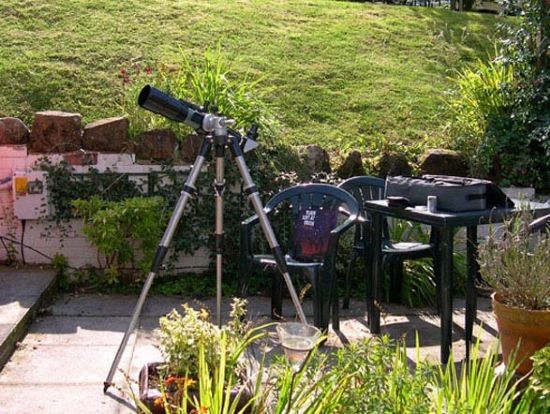
So my ‘review’ draws to a close. I had owned this telescope for a couple of years before the trip, so it was not like I was testing a ‘scope that was new to me, but I thought a journal of night to night experiences might be interesting, and perhaps this would show how useful the TeleVue 85 can be as a travel ‘scope.
The whole shebang did not take up much room in the car, was not too heavy to carry in and out in one-piece, and was extremely quick to deploy. I never had to worry about cool-down times, as the difference in temperature between indoors and out was never very great. I was glad that I had taken my finder-scope though; it was one small addition that made life just a little bit easier.
The optics of the TeleVue 85 performed flawlessly (as I expected), and the views, whether high or low power, were always sharp and clear. I was particularly impressed with its daytime performance as well - something I had not really spent much time on before. Basically, it was a joy to use, with only some very poor sky conditions bringing a dampener to the experience. I have to say that this particular TeleVue 85 will hopefully continue to be my travel-scope for a long while to come.
Now, when is my next holiday due?